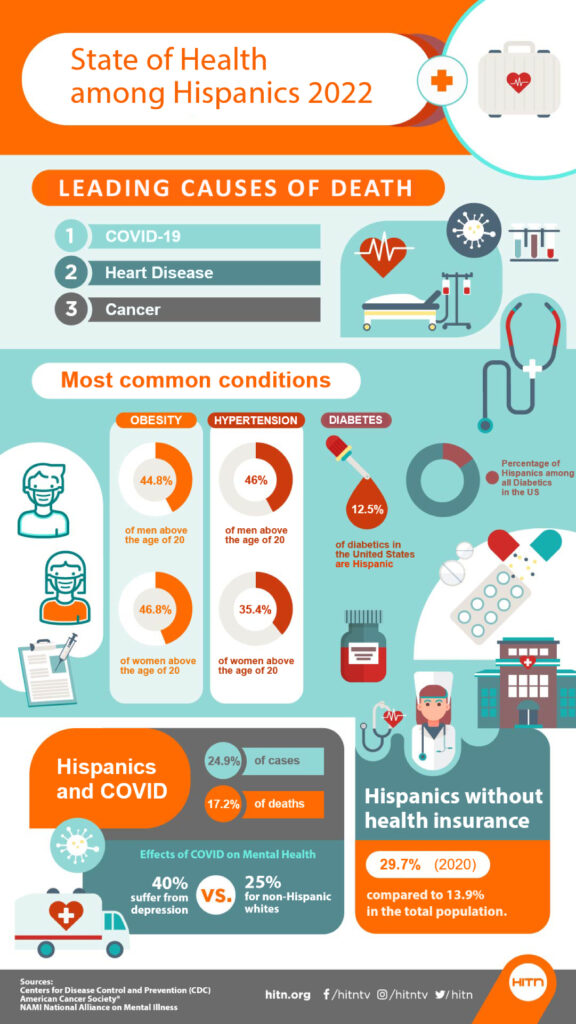April is National Minority Health Month. HITN and Vida Y Salud compile important information that shows the current state of health to one of the communities hardest hit by the pandemic.
Brooklyn, NY – COVID-19 pandemic has once again highlighted the concerning health situation faced by Hispanics in the United States, particularly where mental health is concerned. With April being National Minority Health Month, HITN and Vida y Salud have collected the latest statistics, which paint a current picture of the health of the country’s largest and fastest growing minority group. According to the latest Census data, collected in 2020, 62.1 million people in the United States are Hispanic, a number that represents 18.7 percent of the country’s total population.
Primary causes of death and most common illnesses among Hispanics
- Hypertension (46.0% of men and 35.4% of women over 20), obesity (44.8% of men and 46.8% of women over 20), and diabetes (12.5% of diabetic people in the United States are Hispanic, the second largest group after Native Americans) are highlighted as common conditions among Hispanics that contribute to heart disease, one of the leading causes of death.
- Along with heart disease, cancer is another leading cause of death among Hispanics. Together they represent nearly 2 out of 5 deaths, a rate nearly identical to that observed in Caucasians.
- According data from the American Cancer Society, prostate and breast cancer are the most common forms of cancer among Hispanic men and women, respectively. In their most recent report, this organization estimates that, in 2021, around 23,800 Hispanic men and 22,700 Hispanic women would die of cancer, with lung cancer being the leading cause of cancer-related deaths for men and breast cancer being the leading cause among women.
The COVID factor
- Since 2020, COVID-19 has become one of the three leading causes of death in Hispanics. In fact, among the general population, Hispanics represent 24.9% of cases and 17.2% of deaths.
- According to the Centers for Disease Control and Prevention (CDC), in 2020 COVID-19 claimed hundreds of thousands of lives in the United States, which marked a record increase in mortality rates and a nearly two-year reduction in life expectancy.
- The yearly increase was even more significant among minorities. Mortality rates among Hispanics grew by a margin approximately three times as large as the one for Caucasians. Mortality rates among Hispanic males increased by nearly 43%, and mortality rates increase by 28% among black males. Meanwhile, mortality rates among white males increased by approximately 13% since 2019.
Mental health and Hispanic people
- Regarding mental health, the Latino community is just as susceptible as the rest of the population. However, the concerns, experiences, and ways of addressing and treating them may be different.
- The most common mental health conditions in the Latino community are: schizophrenia, generalized anxiety disorder, depression, post-traumatic stress disorder, and bipolar disorder.
- According to a survey conducted by the CDC, adult Latinos are the group most affected by pandemic-related stress. The CDC report revealed that, among Latinos, the prevalence of depression was 40%, compared to 25% among non-Hispanic white individuals.
- Suicidal thoughts reached 23% among Latinos, compared to 5% among African Americans and 5% among Caucasians.
“During National Minority Health Month, it’s important to consider that Hispanics frequently experience worse outcomes regarding their health due to a lack of access to medical care coverage, quality care, and other factors. It’s important to understand where their beliefs regarding prevention, mental health, and chronic illnesses may differ. Addressing language and cultural barriers is especially important because that allows medical professionals to better diagnose and treat Latinos. Communication is key,” says Dr. Aliza Lifshitz, founder and editorial director of Vida y Salud.
“In reality, we’re all interested in our health. Health inequities don’t just affect the people and communities that experience them, they’re harmful to the entire country. At HITN and Vida y Salud, we want to help our community by providing accessible health information. We hope that it helps improve to your lives.”
Sources:
CDC: Mortality Rates Mortality in the United States, 2020
CDC: Health Disparities
CDC: Morbidity and Mortality Weekly Report
American Cancer Society: Datos y estadísticas sobre el cáncer entre los Hispanos/Latinos
CDC: Health of Hispanic or Latino Population
CDC: National Diabetes Statistics Report 2020



